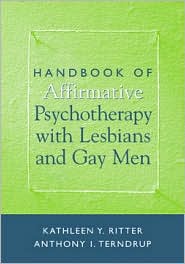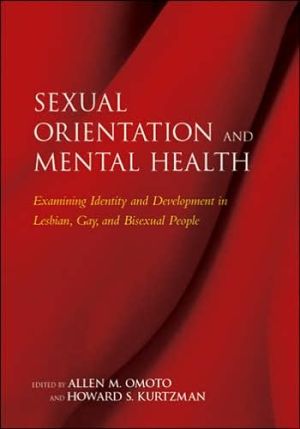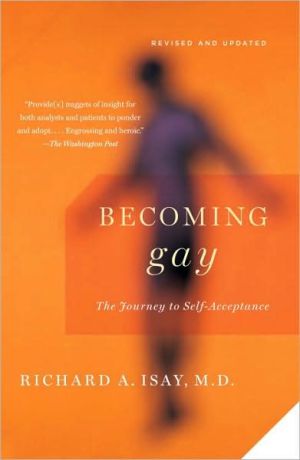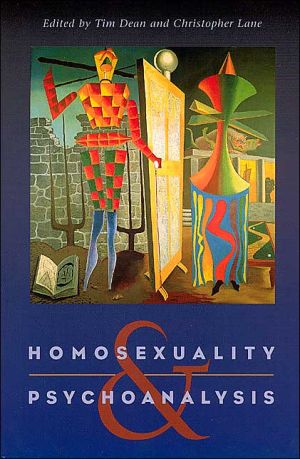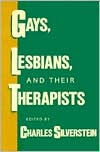Handbook of Affirmative Psychotherapy with Lesbians and Gay Men
Affirmative mental health practice with lesbian, gay, and bisexual clients requires more than good intentions--clinicians need research-based knowledge and expert guidance on how to meet the needs of these communities. This comprehensive volume provides a framework for understanding the unique concerns of sexual minority clients and providing informed, effective clinical services. Counselors and therapists will gain a solid understanding of the developmental trajectories of lesbians and gay...
Search in google:
Grounded in current research, this comprehensive volume lays the foundations for effective, affirmative therapeutic practice with lesbian, gay, and bisexual clients. Timely, clinically relevant information is provided to help clinicians understand and address the unique concerns these clients bring to the therapeutic setting. Coverage includes the sociocultural factors that influence lesbian and gay mental health; the process of lesbian, gay, and bisexual identity formation; and lifespan developmental tasks and transitions from adolescence to later life. Also addressed are family of origin issues; couple problems, including sex therapy with same-sex partners; vocational and workplace issues; health and medical concerns; meeting the needs of same-sex parents and their children; religious and spiritual concerns; and cultural diversity issues. The extensive resource section lists a broad array of publications, advocacy groups, and Web-based resources for both professionals and consumers. Booknews Written for clinicians wishing to enhance their psychotherapeutic treatment of sexual minority clients, this guide addresses the special issues this population presents from a positive regard perspective irrespective of the particular type of therapy or problem. Ritter (counseling psychology, California State U., Bakersfield) and Terndrup (counselor education, Oregon State U., Corvallis) discuss the developmental-social-legal context of sexual orientation, identity formation theories and life span issues, affirmative practice, and working with families and couples. The book includes a substantial list of resources and references. Annotation c. Book News, Inc., Portland, OR (booknews.com)
Handbook of Affirmative Psychotherapy with Lesbians and Gay Men\ \ By Kathleen Y. Ritter Anthony I. Terndrup \ The Guilford Press\ Copyright © 2002 The Guilford Press\ All right reserved.\ ISBN: 1-57230-714-5 \ \ \ \ Chapter One\ Psychodiagnostic Considerations \ Ethical practice calls clinicians to consider the heterosexist bias in specific diagnostic categories historically used to classify sexual minority populations. The American Psychiatric Association, for example, declassified and removed homosexuality from DSM-II (American Psychiatric Association, 1968) in 1973. In 1980, however, persistent and marked distress about sexual orientation was classified and introduced as ego-dystonic homosexuality in DSM-III. Though this new classification technically did not survive the manual's revision, its diagnostic criteria were reassigned to sexual disorder not otherwise specified (302.90) in DSM-III-R (American Psychiatric Association, 1987). The Diagnostic Index of the revised text further instructed readers searching for "homosexuality, ego-dystonic" to "See sexual disorder not otherwise specified" (p. 561). Although this cross-reference was deleted from DSM-IV (American Psychiatric Association, 1994), the persistent and marked distress criteria for a 302.90 diagnosis remained unchanged. Given the number of lenses through which same-sex orientation has been seen, diagnostic categories forpsychiatric disorders appear to be "arbitrary constructions" and "reflections of cultural values that change over time" (Gould, 1995, p. 10). As these social constructions reflect the evolving heterosexist perspectives and values of society, some of the diagnostic categories of DSM mirror the bias of the macroculture (C. Silverstein, 1991, 1996; J. Smith, 1988).\ Cultural heterosexism, nonetheless, often evokes persistent and marked distress about sexual orientation (or sexual differentness in those not yet aware of their homosexuality) that can contribute to various psychiatric disorders. Several presentations, including those of dysthymia or endogenous depression in highly closeted clients, can be manifestations of underlying distress about gender or sexual identity that lift dramatically when these individuals come out (Gonsiorek, 1982; J. Smith, 1988). The literature is replete with single-subject case studies of homosexual patients that either fail to consider or neglect to mention sociocultural influences on the diagnosed disorder. This lack of attribution tends to reinforce the association between homosexuality and various psychopathologies, such as borderline personality disorders, dysthymia, hypomania, homosexual panic, and homosexual erotomania (Baptiste, 1990; Eminson, Gillett, & Hassanyeh, 1989; Issroff, 1988; Jafri & Greenberg, 1991; Signer, 1989).\ This chapter discusses the influence of heterosexist bias on diagnosis. Emphasis is placed on the need for clinicians to understand common psychological and behavioral manifestations of psychically embedded heterosexism during the coming-out process. Guidelines are provided to assist in formulating a diagnosis that is clinically accurate but nonetheless accounts for the effects of this internalization. Paranoia, hypomania, borderline personality disorder, three characterological-appearing overlays to personality structures, and gender identity disorder are illustrated specifically in this regard. Accordingly, diagnostic criteria for these disorders or syndromes are compared with features manifested when otherwise functional individuals present with a sexual identity crisis or with atypical developmental differences.\ HETEROSEXIST BIAS IN DIAGNOSIS\ A growing body of research describes gender, ethnicity, and class bias in diagnosis (McGrath, Keita, Strickland, & Russo, 1990; Roades, Weber, & Biaggio, 1998; D. Russell, 1985, 1986). Examples include:\ perceiving clients as more disturbed and requiring more treatment based on sexist, racist, and classist assumptions (overpathologizing)\ attributing symptomology to group membership rather than to psychopathology (minimizing)\ overdiagnosing or underdiagnosing as a function of group membership\ Although these examples are thought to apply further to sexual orientation bias in diagnosis (Committee on Lesbian and Gay Concerns, 1991; Gonsiorek, 1982; McHenry & Johnson, 1991), there is little empirical research that has examined the relationship between homosexuality and certain diagnostic categories. There also are no studies available that investigate how perceptions of this association influence specific diagnostic assignments. Finally, there has not been a systematic investigation of possible clinician bias with respect to assignment of diagnosis and judgment of psychological functioning (Biaggio, Rhodes, McCaffery, Cardinali, & Duffy, 1996).\ One extensive survey, however, was conducted by a task force of the Committee on Lesbian and Gay Concerns (1991) of the American Psychological Association. After 2,544 psychologists responded to a questionnaire, the Committee published a report on bias in psychotherapy with lesbians and gay men. Key themes and examples of biased, inadequate, or inappropriate assessment were summarized, including:\ the belief that "homosexuality per se is a form of psychopathology, developmental arrest, or other psychological disorders" (p. 10)\ the automatic attribution of client problems to sexual orientation without corresponding evidence\ Further, the Committee on Lesbian and Gay Concerns (1991) provided illustrations of exemplary assessment practice, including:\ the recognition of "the multiple ways that social prejudice and discrimination can create problems that lesbians and gay men may seek to address in therapy"\ the consideration of "sexual orientation as one of the many important attributes that characterize a client" without the assumption that "it is necessarily relevant to the client's problems" (Garnets et al., 1991, p. 968)\ Exemplary practice thus incorporates consideration of relevant sociocultural variables, including the role of heterosexist influences on mental health, when conducting evaluations (Bieschke & Matthews, 1996; Cabaj, 1988b; McHenry & Johnson, 1991).\ Data from additional surveys regarding therapist bias reveal inconsistent findings depending on the clinician population being studied. Rubinstein (1995) sampled 417 Israeli clinicians and found that they rated a hypothetical homosexual client's mental state more severely than that of a heterosexual client with the same diagnosis. Similarly, another study (Lilling & Friedman, 1995) examined the relationship between the attitudes of 82 psychoanalysts toward gay patients and their clinical assessments of these individuals on three measures. Results indicated that the clinicians held a subtle but significant negative bias toward homosexual patients, especially those with serious psychopathology.\ The findings are far more affirmative, however, in studies in which the therapists surveyed are from more diverse backgrounds (i.e., not exclusively or predominately psychiatrically or psychoanalytically trained). For example, 422 members of the Psychotherapy Division (29) of the American Psychological Association were randomly selected and surveyed to assess clinician bias with respect to judgments of disturbance as a function of client sexual orientation (Biaggio et al., 1996). Using a hypothetical client with varying demographic characteristics, results indicated that clinicians displayed no strong evidence of bias against gay men and lesbians and made few significant differentiations of disturbance between sexual orientation groups. Similarly, Liddle (1999a) surveyed 366 gay and lesbian clients of counselors, psychologists, psychiatrists, and social workers and asked them to rate the helpfulness of their therapists. She also adapted from Garnets et al. (1991, described previously) a 12-item checklist of both inadequate and exemplary therapist practices and asked respondents to indicate whether their therapist had exhibited these practices. Clients of counselors, psychologists, and social workers were quite positive in their ratings; an average of 70% perceived their therapists as very helpful, 22% as fairly helpful, 5% as not at all helpful, and 3% as destructive. Ratings of psychiatrists were somewhat less favorable; 50% considered their psychiatrists very helpful, 26% fairly helpful, 9% not at all helpful, and 15% destructive. Although these ratings reflect far less clinician bias than in the earlier eras (see Chapter 2), psychodiagnostic considerations continue to warrant attention (Liddle, 1999b).\ STIGMA, STRESS, OR PSYCHOPATHOLOGY?\ As introduced in Chapter 1, Allport (1954) asserted that (1) no one can remain unaffected by the degradation of others, and (2) self-protectiveness often is encountered among members of groups that are stereotyped and stigmatized. Accordingly, people who are discriminated against and disparaged frequently experience extensive intrapsychic and interpersonal consequences. Among the "traits due to victimization" or "persecution-produced traits" to which Allport (1954) referred, these adverse effects include social withdrawal and passivity as well as obsessive anxiety, suspicion, and insecurity. Many of these characteristics describe lesbians, bisexuals, and gay men living without the support of family and community in a heterosexist and homophobic society.\ Specifically, the association between internalized homophobia and psychological distress was assessed in 738 gay men (I. H. Meyer, 1995; I. H. Meyer & Dean, 1998). Separate multiple regression analyses revealed that the degree to which the men had internalized societal heterosexism was correlated with demoralization (a generalized measure of distress that includes symptoms of anxiety and depression), guilt feelings, and suicidal ideation. The authors, in fact, noted that "internalized homophobia is associated with a two- to threefold increase in risk for high levels of psychological distress" (I. H. Meyer & Dean, 1998, p. 173).\ Chapters 3 and 15 extend this discussion further by considering the effects of internalized homophobia on superego functioning, elaboration of defenses, patterns of cognition, and object relations (Malyon, 1982), along with other consequences of oppression such as ego fragmentation and intense anxiety (Forstein, 1986; Malyon, 1982). These and other prevalent reactions to heterosexist bias, as well as the emotional and behavioral manifestations of a sexual identity crisis (Chapter 9), frequently resemble psychiatric symptomatology (Dworkin, 2000a; Gonsiorek, 1982, 1991; Gonsiorek & Rudolph, 1991).\ Gonsiorek (1982) contends that the coming-out process often generates elaborate symptoms that appropriately are perceived as frightening, ego alien, and contributing to significant subjective distress. He believes that although equilibrium usually returns with time, many individuals do respond in "temporarily dramatic ways" consistent with their styles (p. 15). He maintains that unbiased clinical practice (Committee on Gay and Lesbian Concerns, 1991) mandates the ability of clinicians to distinguish among sexual minority clients:\ With clinically significant psychiatric disorders\ Who experience a particularly difficult time coming to terms with their sexuality but in whom serious underlying psychopathology is not present\ For whom the coming-out crisis serves as a precipitating event for the manifestations of serious underlying problems\ Table 8.1 outlines these three possibilities and Gonsiorek's (1982) differential diagnoses between a sexual identity crisis and psychopathology, particularly paranoia and hypomania. He selected paranoia for discussion because of the traditional Freudian belief that it represents a defense against homosexual impulses. He contends that any serious threat to core sexual identity may elicit paranoid defenses, but the association between homosexuality and paranoia continues to persist. J. Smith (1988) believes similarly that although psychotic disorders do not occur with any greater frequency among sexual minorities, paranoia is particularly prone to be overdiagnosed and should be considered only if it is clear that the hypersensitivity, restricted affect, and pervasive suspiciousness are completely unwarranted given the degree of danger. Gonsiorek (1982) also choose to focus on hypomania because of the frequent differential diagnostic problems that exist between affective disorders and the mood swings, hyperactivity, and impulsive behaviors sometimes exhibited during a sexual identity crisis. Hypomania and paranoia, along with borderline personality disorder and characterological-appearing overlays of the personality structure are discussed separately later. The chapter concludes with a consideration of gender identity disorder and the high potential for bias inherent in this diagnostic category.\ Paranoia\ During a psychotic episode, thought-disordered clients of any sexual orientation may be distressed considerably by delusions or ideas of reference about homosexuality. Similarly, sexual minority individuals who are having a difficult time accepting their homosexuality can experience panic and may appear thought-disordered and paranoid. Finally, gay, lesbian, or bisexual clients who are psychotic may decompensate during a sexual identity crisis and become delusional and paranoid (see Table 8.1). Figure 8.1 outlines Gonsiorek's (1982) conceptualization for differentiating among these three possibilities. He believes that clinicians must first determine the orientation of a client's sexual desires (i.e., to the same sex, other sex, or both) in order to rule out delusions which are "cerebral, ruminative ideas with little or no component of homosexual desire, either in the present or past, as determined by history" (p. 11).\ Once the present sexual orientation of a client is determined as clearly as possible, the nature of the paranoid (or paranoid-appearing) ideation must be examined. Delusions of reference about homosexuality tend to lack a base in reality, and the connections between the fantasies and same-sex orientation often are more tenuous and idiosyncratic. On the other hand, the suspicions of gay men and lesbians during a sexual identity crisis are more likely to be reality based and to result from such experiences as severe interpersonal rejection, physical or sexual assault, or impending job loss. A detailed history, then, is essential in making this differential diagnosis. Finally, both homosexuality and paranoid schizophrenia may be present. This combination may be seen particularly in individuals whose functioning was marginal prior to the sexual identity crisis and for whom the emergence of homosexual desire, behavior, or both precipitates a psychotic episode.\ \ Continues...\ \ \ \ Excerpted from Handbook of Affirmative Psychotherapy with Lesbians and Gay Men by Kathleen Y. Ritter Anthony I. Terndrup Copyright © 2002 by The Guilford Press. Excerpted by permission.\ All rights reserved. No part of this excerpt may be reproduced or reprinted without permission in writing from the publisher.\ Excerpts are provided by Dial-A-Book Inc. solely for the personal use of visitors to this web site. \ \
Introduction1Affirmative Psychotherapy1Psychotherapy Literature2Guidelines for Psychotherapy3Focus of Treatment5Overview of the Book6Part I.Social, Developmental, and Political FoundationsChapter 1Heterosexism: A Fundamental Reality11Heterosexist Assumptions and Their Negative Impact13Popular Opinion14Media15Stereotypes16Correlates of Heterosexism17Effects of Heterosexism on Mental Health22Conclusion24Chapter 2Concepts of Sexual Orientation25Historical Perspectives25The Classification of Homosexuality27Contemporary Models of Sexual Orientation32Bisexuality37Social Constructionism44Conclusion46Chapter 3Sexual Orientations: Origins and Influences47Development and Minority Sexual Orientations48Conclusion66Chapter 4Sexual Orientation and the Law68Constitutional Rights69Legal Concerns of Sexual Minority Clients70Legal Protection for Sexual Minority Clients84Conclusion85Part II.Identity Formation and Psychological DevelopmentChapter 5Theories of Gay, Lesbian, and Bisexual Identity Formation89Lesbian and Gay Identity Development Models90Bisexual Identity Formation108Conclusion112Chapter 6Issues for Sexual Minority Adolescents114Gay, Lesbian, and Bisexual Adolescent Issues115Psychotherapeutic Considerations126Conclusion128Chapter 7Midlife and Later-Life Issues for Sexual Minority Adults130Midlife131Later Life135Conclusion145Part III.Affirmative PracticeChapter 8Psychodiagnostic Considerations149Heterosexist Bias in Diagnosis150Stigma, Stress, or Psychopathology?151Gender Identity Disorder162Conclusion167Chapter 9Psychotherapeutic Applications for Identity Formation168Phase-Specific Psychotherapeutic Interventions169Factors Affecting Movement along the Trajectory181Conclusion188Chapter 10Sexual Minorities within Other Minority Populations189Identity Formation190Cultural Factors194Specific Populations202Psychotherapeutic Considerations216Conclusion220Chapter 11Career Choice and Development with Sexual Minority Clients221Theoretical Adaptations to Sexual Minority Clients221Lesbians and Work228Career Counseling with Sexual Minority Clients230Conclusion237Chapter 12Health and Medical Concerns239Barriers to Seeking Healthcare239Chemical Dependency241Lesbian Health Concerns250Gay Men's Health Concerns256Conclusion271Chapter 13Religious Concerns and Spiritual Development272Religion and Sexual Minorities272Sexual Minorities and the Viability of Religion274Religion-Based Conversion277Revitalizing Religion for Sexual Minorities283Reformulating Spirituality for Sexual Minorities285Conclusion291Part IV.Working with Couples and FamiliesChapter 14Families of Origin and Coming-Out Issues295Families of Origin295Parents298Conclusion311Chapter 15Understanding Same-Sex Couples312Heterosexism312Gender Role Socialization320Relationship Stages332Conclusion343Chapter 16Sex Therapy with Gay and Lesbian Couples344Heterosexist Bias344Assessment349Sexual Dysfunctions351Conclusion365Chapter 17Families with a Gay, Lesbian, or Bisexual Parent367Formation of Families368Sexual Minority Parents372Children376Conclusion387Resources389Bisexuality389Bookstores and Publishers389Chemical Dependency390Culturally Specific Resources391Family393Legal and Advocacy394National Publications397Professional Journals398Professional Organizations399Religious Organizations400Sexual Minority Health405Sexual Minority Seniors408Sexual Minority Youth409Violence and Harassment412References413Index477
\ From the Publisher"Excellent....This book is clearly written and attractively and helpfully laid out. It offers a copious appendix of resources....Thoughtful study of this book will reward readers with an excellent education in working with lesbians and gay men to achieve a position for them in society that is no longer debilitating but healthful, respected, and possibly, esteemed."--Canadian Journal of Psychiatry\ "Finally, a core text for the practice of lesbian and gay affirmative psychotherapy has arrived. This book is scholarly, clinically savvy, comprehensive, thoughtful, accessible, and pragmatic. The authors do a remarkable job of advancing a coherent point of view while remaining even-handed, balanced, and receptive to a diversity of ideas. I recommend this book without reservation to any mental health provider working with lesbian and gay clients, and to scholars seeking a basic reference on the practice of lesbian and gay affirmative psychotherapy."--John C. Gonsiorek, PhD, ABPP, Past President, American Psychological Association Division 44; Independent Practice, Minneapolis, MN\ "This book meets a longstanding need in the professional literature. It is comprehensive, well grounded, and practical in its focus on the underlying issues and challenges that emerge in clinical work with lesbians and gay men. This book is an invaluable addition to the bookshelves of all mental health practitioners, as well as students. Including an extensive resource list, the book will be a useful text for courses in human sexuality, multicultural counseling, and counseling sexual minorities."--Bob Barret, PhD, Department of Counseling, Special Education and Child Development, University of North Carolina at Charlotte\ "This comprehensive text not only includes all the relevant psychological literature, but also provides the reader with a sociopolitical context for understanding how heterosexism impacts the lives of lesbian, gay, and bisexual people. A unique aspect of the book is the thorough presentation of affirmative psychotherapy interventions. Particularly noteworthy is the discussion of misdiagnosis that occurs when stress associated with having a stigmatized identity is mistaken for evidence of psychopathology. This text should be required reading for graduate students in the mental health professions, as well as practitioners working with diverse lesbian, gay, and bisexual clients. Many sections of the book would also be useful for undergraduate students in Psychology, Sociology, and Women's, LGBT, or Gender Studies."--Christine Browning, PhD, Senior Staff Psychologist, University of California, Irvine Counseling Center; Past President, APA Division 44 (Society for the Psychological Study of Lesbian, Gay, and Bisexual Issues).\ "Training of mental health professionals is improving when it comes to education about LGB clients, but there are still many graduate programs and many textbooks that barely touch on these important issues....The amount of research reviewed here and the implications drawn from that research are outstanding....No matter how knowledgeable readers believe themselves to be on LGB issues and no matter whether students, therapists, educators, or researchers, they will be pleased at how much more they will learn from this book."--from the Foreword by Sari H. Dworkin, PhD\ \ \ \ \ \ \ Contemporary Psychology"An excellent resource for ideas about how to create the best possible therapeutic environment for a sexual minority client."--Contemporary Psychology\ \ \ Journal of Cognitive Psychotherapy"This useful and comprehensive volume addresses the needs of the psychotherapeutic community in capturing the complex multidimensionality of LGB experience in today's society and the psychological issues that surround this....A supremely useful book that can inform both straight and LGB therapists."--Journal of Cognitive Psychotherapy\ \ \ \ \ Social Work Today"From the LGB teenager to the senior citizen and the single gay man to the committed lesbian couple, the Handbook details the rich and varied aspects of sexual minorities in clear, concise details that will enable the mental health professional to better connect with this often underserved segment of the population."--Social Work Today\ \ \ \ \ From The CriticsWritten for clinicians wishing to enhance their psychotherapeutic treatment of sexual minority clients, this guide addresses the special issues this population presents from a positive regard perspective irrespective of the particular type of therapy or problem. Ritter (counseling psychology, California State U., Bakersfield) and Terndrup (counselor education, Oregon State U., Corvallis) discuss the developmental-social-legal context of sexual orientation, identity formation theories and life span issues, affirmative practice, and working with families and couples. The book includes a substantial list of resources and references. Annotation c. Book News, Inc., Portland, OR (booknews.com)\ \
